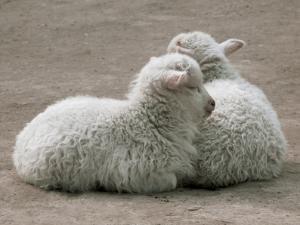| |



|
These lambs will soon be ready for their first shearing. Shearing does not cause any pain for the sheep -- it's like getting a haircut. In the spring, removing the heavy coat the sheep has grown for warmth during the winter will help to keep the sheep cool and clean during the summer.
After the shearing, the sheep will sometimes be put in a jacket to keep the wool clean when the sheep goes out into a wet meadow or lies down in a bed of straw.
|
|
The wool from the shearing, which is called a fleece, is then ready to begin it's journey towards becoming yarn that can be made into sweaters, hats, mittens, scarves, and so many other items.
|

It's common practice these days to first wash the wool before doing anything further with it. Washing is necessary not only to remove dirt, but also to remove some of the natural lanolin that sheep produce. Lanolin is a wonderful substance. It repels water and has natural anti-bacterial and anti-fungal properties. Because lanolin is easily absorbed by human skin and is hypoalergenic, you will find it in many pharmaceutical and cosmetic products. Lanolin can also be used to finish and preserve leather or as a lubricant and rust inhibitor for tools and machinery.
A healthy sheep will produce a lot of lanolin to keep its coat water-proof and to protect its skin from infection. This is why "raw wool" (i.e. wool from shearing that has not been washed or otherwise processed) has a greasy feel. When wool has been properly cleaned, some lanolin remains in the wool to help keep it soft and somewhat water resistant. Washing wool garments with cleaning products made specifically for wool helps to retain the right amount of lanolin, in addition to reducing the risk of unwanted shrinkage and felting.

|
|

